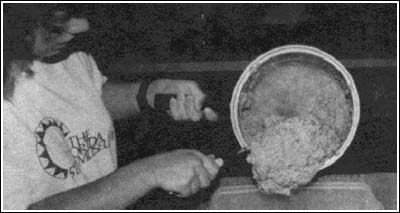

 |
||||||||||||
 |
||||||||||||
| Microworm Culture for Aquarium Fish Producers | ||||||
| R.W. Rottmann | ||||||
Live food is considered to be a necessity for raising fish fry, especially during the first weeks of feeding. Most fish fry require a food item that shows independent movement. This live food must also be appropriate for the mouth size of the fry and must provide a nutritionally complete diet. Fish culturists have historically used newly hatched brine shrimp almost exclusively as the initial food for fry. Brine shrimp, however, have some disadvantages as a fry food. For many fish species, newly hatched brine shrimp are much too large to be ingested. Hatching procedures for brine shrimp require aeration, and as a result, power outages can cause complete failure. Brine shrimp in fresh water die within a few hours because of osmotic stress. In addition, the cost of brine shrimp cysts is substantial. Biology The nematode Panagrellus sp., commonly known as "microworms" to tropical fish hobbyists are an alternate live food for fry. Microworms are one of the simplest live foods to culture. They produce a dependable harvest and are tolerant of environmental variables. These nematodes are small (usually less than l/16" long), white, unsegmented worms that move continuously. The tail end is pointed while the mouth end is more rounded. They are approximately 15 times as long as they are wide. Because of their size and shape, they can be fed to fish that are too small to take a brine shrimp nauplii. Microworms remain alive in fresh water for twelve hours or more. Microworms reproduce sexually. The males have a curved tail, are smaller, more slender, and less numerous than the females. Microworms are live bearing, releasing 10 to 40 young every 1 to 1.5 days for a 20 to 25 day life span. Therefore, each female produces approximately 300 young. The young reach sexual maturity in approximately three days. Their size increases by three times during the first day and five to six times during the next three days. The nematodes are 76% water and 24% dry matter; 40% of the dry matter is protein and 20% is fat. Microworm Cultures Starter cultures are available from biological supply houses, mail order companies that advertise in aquarium magazines, or other fish culturists. A starter culture can be stored for over six months at slightly above 32°F. Microworms can be cultured in almost any shallow, flat, water tight container; 8" x 12" plastic refrigerator boxes with snap on lids are especially convenient for large-scale production. Approximately ten 1/16 if holes are drilled in the top for air. The culture media can be prepared from almost any cereal grain, yeast, and water. My experience has shown that rolled oats, available from livestock feed stores in 50-pound bags, is one of the best choices for maximum production and economy. Use approximately 1 to 1-1/2 pints of rolled oats with one quart water for each 8" x 12" container. The oats are cooked for 5 to 7 minutes, covered, and allowed to cool. If the mixture is not cooked, only approximately 2/3 as much water is needed, however, mold and insect infestation from spores and eggs in the oats may be a problem. The mixture should have a very thick paste-like consistency. The media is spooned into the culture container (Figure 1) and spread to a thickness of ½" to 3/4". A tablespoon or more of baker's yeast is sprinkled over the oatmeal and mixed in. The starter culture of nematodes is then spread over the surface. Any media on the sides of the container should be removed with a damp cloth, to prevent it from being introduced into the fry tank. The mixture will decay rapidly in water and may cause water quality problems for the fry. 
Figure 1 more... |
 |
|||||
| About Us :: Message Board :: Chat | |||||
| Library :: Photo Gallery :: Links & Resources :: Breeders & Sponsors :: Merchandise | |||||
| Website designed by: EthanCote.com | © 2001-2004, SimplyDiscus.com. All Rights Reserved. | ||||